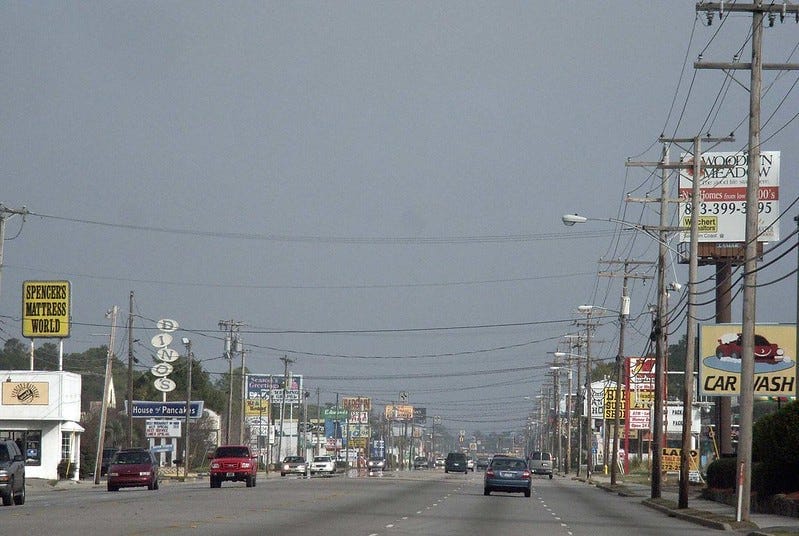This road is killing America
Seemingly every town and city in North America has one of these roads. Four or six lanes across, the road is lined with everything from…

Seemingly every town and city in North America has one of these roads. Four or six lanes across, the road is lined with everything from self storage units, to car dealerships, to drive thru fast food. There are traffic lights every five hundred feet and cars are constantly turning in and out of the road, with their drivers sometimes stuffing handfuls of fries into their mouths.
There’s usually sidewalks on these streets, but curiously no pedestrians. Everyone in town has to go down this road at least once a week because the local supermarket, surrounded by several acres of parking lots, is always on this street.
It’s a street, with local commercial destinations, but it’s also a road that is supposed to connect you at high speed to the next town. Sometimes an entire town’s commercial base on one of these street/roads. These motorways are called stroads because they try to be both a street and a road at the same time and fail miserably at both.
Generally, America (and other parts of the world) make two types of roads that are very safe: highways and streets.
Highways and roads are designed to get you from one town to the next at high speeds. They have roomy lanes, wide shoulders, and sweeping, gentle turns that signal to drivers that they can drive fast.
Streets are designed to be travelled at low speed to maximize local access to homes and businesses for people. That last bit is important, streets are designed for people, not drivers. Streets are intentionally complex environments where drivers must pay attention to many things at once, pedestrians, other cars, cyclists, and even their destination.
Stroads are big, wide, roomy roads, lined with hundreds or driveways for businesses and even houses sometimes. Author and (former?) engineer Charles Marohn explained in his book “Confessions of a Recovering Engineer” that the wide lanes and smooth turns of a stroad lull a driver into thinking they can drive faster and less attentively, as they would on a highway. But in actuality, the stroad has all the same local connectivity as a city street, with pedestrians and entering and exiting traffic.
These roads are obviously awful for pedestrians, as it forces people to walk mere feet from a car traveling 50 mph, a lethal speed for anybody not in a car (and also deadly for quite a few people in a car).
These are the most dangerous roads in America and they’re everywhere. A great many essential commercial spaces, like grocery stores, sit on stroads, and they’re dangerous to walk. It’s easy to seee why nobody walks to actually get to important places anymore.
I recently discovered an amazing bagel place near my new place in New England. It’s definitely walking distance away, being just 15 minutes each way. But it’s on a stroad, and walking there for the first time the other day was awkward at best. At one point there was no sidewalk in an otherwise pretty walkable town. I’ll think twice about walking there next time.
No wonder America is continuously getting less healthy over time. Walking from our houses to our cars and from the parking lot at work into work isn’t much. Before cars, cities were designed for walking because it was the only way to get around. Horse drawn buggies and eventually trolleys helped extend the distance a person could cover on foot.
Once cars were invented however, we seemingly threw out millennia-old ideas about designing cities for walking and replaced it, all of it, the trolleys, the trains, everything, with stroads. We love places and places are built through walking.
Think about your own town. Think of the last five businesses in your area that you shopped at. If all of them disappeared tomorrow, would you feel anything? I don’t know about you but the bagel place I dodged death to walk to is not good enough for fond memories. I don’t live in a place, I live near a stroad.
I’m planning to write an on-going series about American city design, as I’ve spent a lot of time thinking and learning about it. Stay tuned to this space for more.
If you appreciated this piece, consider contributing to my Patreon to support more work.



